| 2007
Top Ten Endangered Sites
Top 10 2007 |
< Back |
Next >
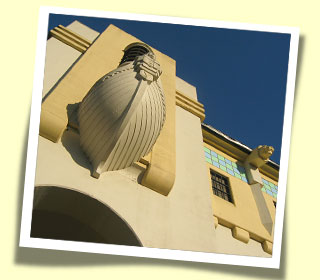 Completed in 1932 to provide a high-level crossing to the western neighbourhoods, Burrard Bridge is a triumph of civic architecture and a key gateway structure. Completed in 1932 to provide a high-level crossing to the western neighbourhoods, Burrard Bridge is a triumph of civic architecture and a key gateway structure.
Architects Sharp & Thompson, conscious of the bridge's ceremonial function, embellished the utilitarian steel superstructure with imposing concrete towers, art deco sculptural details, and torch-like entrance pylons that are a silent war memorial.
Heavy concrete railings, originally topped by decorative street lamps, unify the parts.
Since the 1990s, the Engineering Department has brought forward repeated schemes despite ferocious public opposition to increase the capacity of the bridge. Over 15 years later, the pot still boils: in late 2006, the current Council voted to kill a proposed lane re-allocation trial to test an alternate solution. Instead this Council seems hell-bent on intrusive, expensive schemes favouring the single-occupancy car. Yet another consultant team is presently doing a detailed design of sidewalk expansion of this iconic Art Deco landmark.
The ill-conceived plans to widen the bridge's sidewalks require for support massive cantilevered outrigger structures that would radically alter the bridge's appearance by adding bulky appendages slicing horizontally across the bridge's architectural features. The existing railings would be demolished to make way for new railings pushed out to the edges of the new sidewalks. Without its original railings, the bridge would lose its strong edges, and its defining architectural features would be isolated in a broad expanse of pavement.
For HV, the issues remain the same: how to accommodate increased numbers of cyclists and pedestrians without compromising the heritage architecture and iconic status of the bridge. We are extremely disappointed that other, equally viable options are not being considered. We continue to urge Council to consider carefully the alternatives before rushing to implement a solution that will permanently disfigure this civic landmark.
We continue to ask: What will we show the world in 2010? A quick-fix hatchet job or a restored world-class gateway?
Updates:
View the ongoing updates for the Burrard Bridge here (opens in a pop-up window).
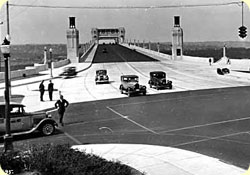 |
|
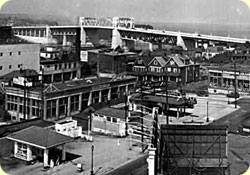 |
| July
6, 1932; Northside approaches to bridge, Burrard
& Pacific Streets; Photo courtesy the Vancouver
Public Library |
|
June
27, 1932; View from NE Granville St & Pacific
St looking NW; Photo courtesy the Vancouver Public
Library |
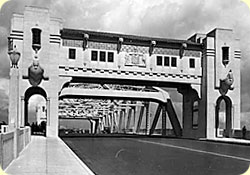 |
|
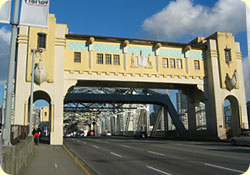 |
| Aug
1, 1932; Looking NE. Note the original lamp standards
to the left of the photo, which once lined the bridge; Photo courtesy the Vancouver Public Library |
|
2007; Same view as photo to the left, 75 years later; Photo Heritage Vancouver |
 |
|
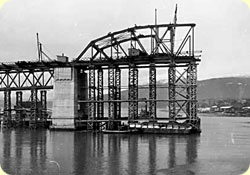 |
| 1932; Looking NE towards downtown. Note the original lamp standards,
which once lined the bridge, helping to visually tie in
the entrance torches/pillars with the centre massing; Photo courtesy the Vancouver Public Library |
|
Jan
30, 1932; Bridge under construction, looking
towards English Bay; Photo courtesy the Vancouver
Public Library |
 |
|
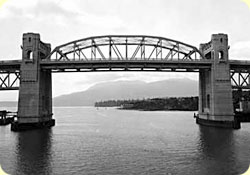 |
| 2007; Detail of the bridge's centre network of steel. The central piers were created to help serve as a gateway to Vancouver, and mask this steel structure; Photo Heritage Vancouver |
|
1932; View looking towards English Bay; Photo courtesy the
Vancouver Public Library |
 |
|
 |
| 2007; Both ends of the span have these large torch-like entrance pylons emulating flames. This was a tribute to Canadian World War I prisoners of war, who huddled around open fires in their prison camps, created by the bridge engineer, John Grant.; Photo Heritage Vancouver |
|
2007; Detail of bridge showing the hull of a boat emerging from the centre massing. Busts of Captain George Vancouver and Sir Harry Burrard jut out above the boat hulls ; Photo Heritage Vancouver |
|

